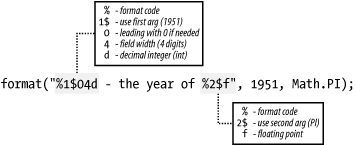Recipe 10.3 Printing with the 1.5 Formatter
ProblemYou have JDK 1.5 and you want the ease of use that the java.util.Formatter class brings to simple printing tasks. SolutionUse Formatter for printing values with fine-grained control over the formatting. DiscussionThe 1.5 Formatter class is patterned after C's printf routines. In fact, PrintStream and PrintWriter have convenience routines named printf( ), which simply delegate to PrintStream 's format( ) method, which uses a default Formatter instance. However, since Java is an object-oriented language, the methods are strongly type-checked, and invalid arguments will throw an exception rather than generating gibberish. The underlying Formatter class in java.util works on a String containing format codes . For each item that you want to format, you put a format code. The format code consists of a percent sign (%), an argument number followed by a dollar sign ($), an optional field width or precision, and a format type (d for decimal integer, that is, an integer with no decimal point, f for floating point, and so on). A simple use might look like the following: System.out.format("%1$04d - the year of %2$f", 1951, Math.PI);As shown in Figure 10-2, the "%1$04d" controls formatting of the year and the "%2$f" controls formatting of the value of PI. Figure 10-2. Format codes examined Many format codes are available; Table 10-1 lists some of the more common ones. For a complete description, refer to the Javadoc for java.util.Formatter.
Some examples of using a Formatter are shown in FormatterDemo.java, in Example 10-1. Example 10-1. FormatterDemo.javaimport java.util.Formatter; /** Demonstrate some usage patterns and format-code examples * of the Formatter class (new in JDK 1.5). */ public class FormatterDemo { public static void main(String[] args) { // The arguments to all these format methods consist of // a format code String and 1 or more arguments. // Each format code consists of the following: // % - code lead-in // N$ - which parameter number (1-based) after the code // N - field width // L - format letter (d: decimal(int); f: float; s: general; many more) // For the full(!) story, see javadoc for java.util.Formatter. Formatter fmtr = new Formatter( ); Object result = fmtr.format("%1$04d - the year of %2$f", 1951, Math.PI); System.out.println(result); // A shorter way of doing things. But this // way you must provide the newline delimiter System.out.format("%1$04d - the year of %2$f%n", 1951, Math.PI); // So is this System.out.printf("%1$04d - the year of %2$f%n", 1951, Math.PI); // Format doubles with more control System.out.printf("PI is about %1$4.2f", Math.PI); } }Running FormatterDemo produces this: C:> javac -source 1.5 FormatterDates.java C:> java FormatterDates 1951 - The year of 3.141593 1951 - The year of 3.141593 1951 - The year of 3.141593 PI is about 3.14 For date and time formatting, a large variety of format codes are available.[2] Each must be preceded by a t, so to format the first argument as a year, you would use %1$tY. Table 10-2 lists some of the more common date and time codes.
In my opinion, using these in applications that you distribute or make available as web applications is a Really Bad Idea because any direct use of them assumes that you know the correct order to print these fields in all locales around the world. Trust me, you don't. Instead of these, I recommend the use of DateFormat, which I show you how to use in Recipe 6.2; I also urge you to read Chapter 15. However, for "quick and dirty" work, as well as for writing log or data files that must be in a given format because some other program reads them, these are hard to beat. Some date examples are shown in Example 10-2. Example 10-2. FormatterDates.javaimport java.util.Formatter; import java.util.Date; import java.util.Calendar; /** Demonstrate some usage patterns and format-code examples * of the Formatter class (new in JDK 1.5). */ public class FormatterDates { public static void main(String[] args) { // Format numbers as dates e.g., 2004-06-28 System.out.printf("%1$4d-%2$02d-%3$2d%n", 2004, 6, 28); // Format fields from a Date object: multiple fields from "1$" // (hard-coded formatting for Date not advisable; see I18N chapter) Date today = Calendar.getInstance( ).getTime( ); System.out.printf("Today is %1$tB %1$td, %1$tY%n", today); // e.g., July 4, 2004 } }Running this FormatterDates class produces the following output: C:> javac -source 1.5 FormatterDates.java C:> java FormatterDates 2004-06-28 Today is March 07, 2004 The astute reader will notice that this mechanism requires that the Java language now contain a variable arguments mechanism. Var args have been the bane of developers on many platforms and, indeed, they have finally come to Java. However, they are not intended for capricious use, and I do not document them here.[3] If you really need to use this mechanism, consult the documentation accompanying JDK 1.5.
|
EAN: 2147483647
Pages: 409
- Step 1.2 Install SSH Windows Clients to Access Remote Machines Securely
- Step 3.3 Use WinSCP as a Graphical Replacement for FTP and RCP
- Step 3.4 Use PuTTYs Tools to Transfer Files from the Windows Command Line
- Step 6.2 Using Port Forwarding Within PuTTY to Read Your E-mail Securely
- Appendix - Sample sshd_config File